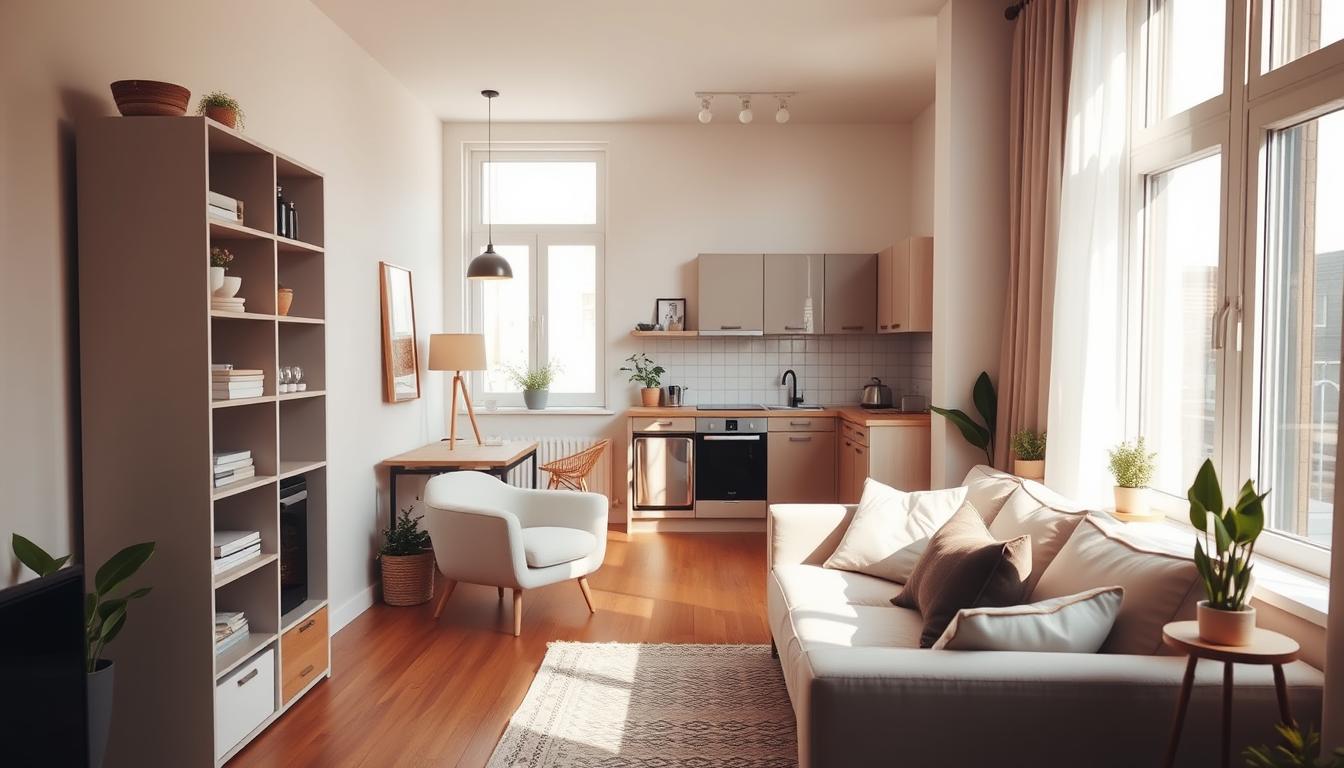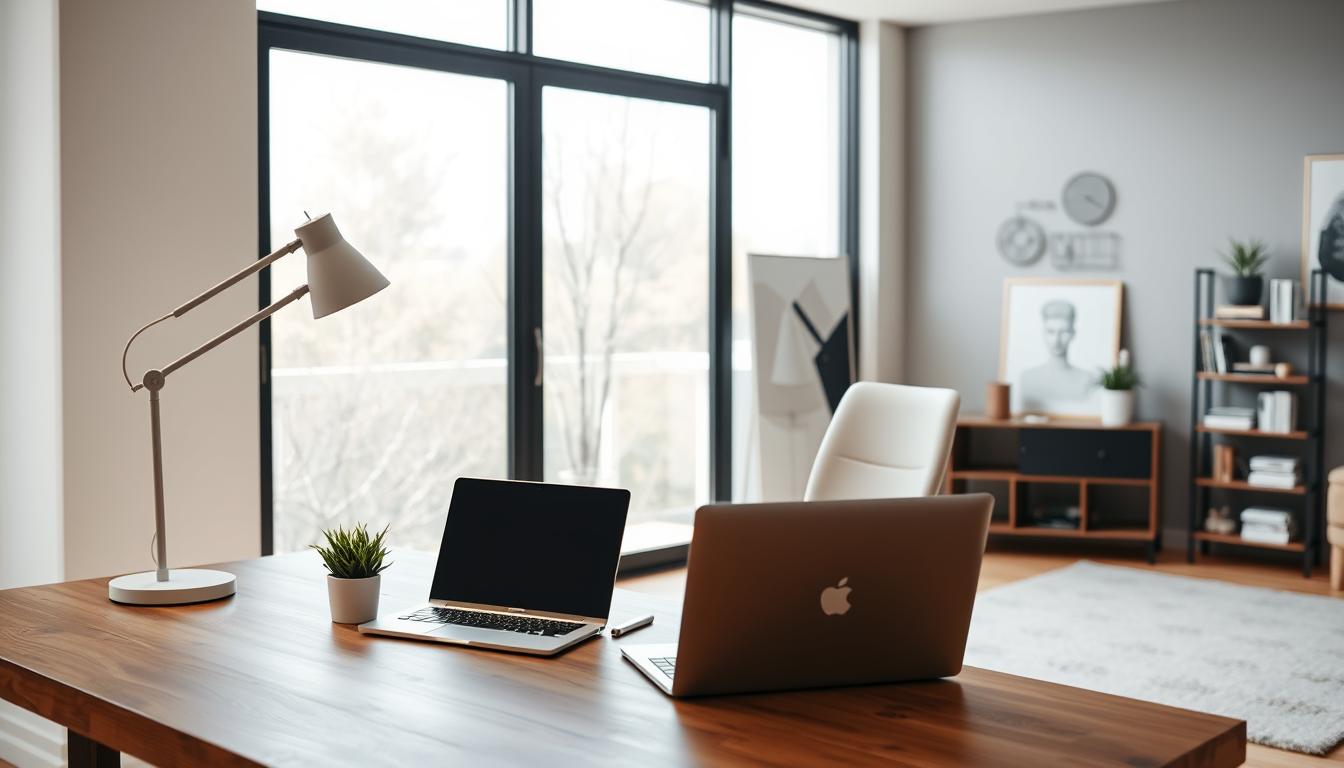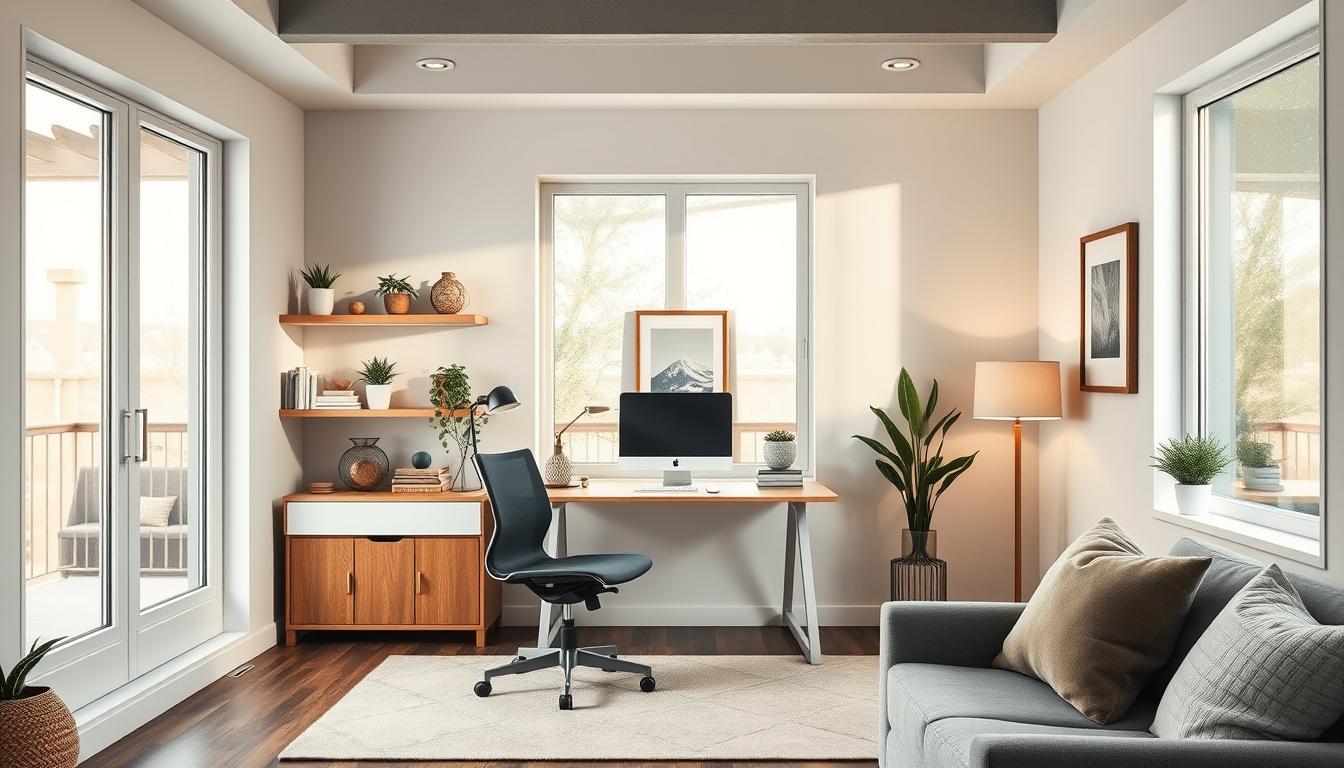Did you know that nearly 25% of homes in the United States are small, with less than 1,000 square feet? This shows the need for effective small space design tips. These tips can turn small living areas into beautiful and functional homes.
We’re excited to share our top interior design strategies for small homes. These expert-approved tips will make your space more livable and attractive.
Key Takeaways
- Optimize your furniture for space-saving functionality.
- Utilize vertical space to maximize storage.
- Select a color palette that creates the illusion of more space.
- Minimize clutter to maintain a sense of openness.
- Leverage natural light to brighten your home.
Understanding the Challenges of Small Space Living
Living in a small space can lead to creative solutions that improve life quality. It’s important to think carefully about how to make a small home both useful and beautiful.
Maximizing Functionality
To make the most of small homes, it’s key to plan the layout well. Choose furniture that does more than one thing to cut down on clutter and make the space feel bigger. For example, a storage ottoman can be a coffee table, a place to sit, and a storage spot.
Key strategies for maximizing functionality include:
- Using wall space with shelves and storage units.
- Picking compact appliances and fixtures that fit the home’s size.
- Adding hidden storage to keep things out of sight.
Creating a Cozy Atmosphere
Making a small home cozy is more than just looks; it’s about creating a warm, inviting space. “A well-designed small space can feel as luxurious as a bigger one, it’s all about the details,” says an interior design expert. Use light colors on walls and floors to make the space feel open. Add warmth and depth with throw blankets and rugs.
By using these tips, homeowners can make their small space cozy and welcoming. This makes the most of the space they have.
Color Schemes to Enhance Small Spaces
Choosing the right colors is crucial for small house interior design. The colors you pick can either make your space feel cramped or open. We’ll look at how to use color to improve your small home’s interior.
Light Colors for an Open Feel
Using light colors on walls and ceilings is a smart space-saving technique for small spaces. Light colors reflect light, making rooms appear larger. White, cream, and soft pastels are great for an airy feel.
For the best effect, try a monochromatic color scheme. This means using different shades of the same color. It creates a cohesive and harmonious look.
Bold Accents Without Overcrowding
Light colors make rooms feel bigger, but bold accents add personality. The trick is to balance light colors with bold accents to avoid clutter.
You can add bold accents with furniture, artwork, or decor. A vibrant rug or a bold piece of furniture can add color without overwhelming the space. The aim is to enhance, not clutter, the space.
Furniture Selection for Limited Areas
To make a small home both functional and stylish, picking the right furniture is key. The right pieces can make a small living area feel bigger and more welcoming.
Multi-Functional Furnishings
Choosing multi-functional furniture is a smart move for tiny homes. These pieces do more than one thing, cutting down on clutter and boosting the space’s use.
- A storage ottoman can be a coffee table, extra seating, and storage all in one.
- A Murphy bed folds up against the wall, freeing up floor space during the day.
- A nesting table set offers extra surface when needed and can be tucked away.
Choosing the Right Size
In small living rooms, furniture size is as crucial as its function. Big pieces can make a room feel tight and cramped.
Here are some tips for picking the right size furniture:
- Measure your space carefully before buying furniture.
- Choose pieces that match your room’s size.
- Opt for slim furniture to avoid overwhelming the space.
| Furniture Type | Size Consideration | Benefit |
|---|---|---|
| Sofa | Slim profile or sectional | Fits into tight spaces, provides ample seating |
| Coffee Table | Nesting or lift-top | Provides flexibility, can be stored away when not in use |
| Desk | Compact or wall-mounted | Saves floor space, ideal for small home offices |
By picking furniture that’s both functional and the right size, you can make a cozy and stylish living area in even the smallest homes.
Creative Storage Solutions
Creative storage solutions can turn cluttered small homes into tidy spaces. In small homes, clutter can make areas feel cramped and overwhelming. It’s key to keep things organized.
To keep your home neat and organized, you need to use space wisely. We’ll look at practical storage ideas that balance style and function.
Under-Bed Storage Ideas
Don’t overlook the space under your bed for storage. Using this area can greatly increase your storage. Think about using under-bed containers or drawers for clothes, bedding, or linens.
- Use bed risers to create more space under your bed for storage bins.
- Opt for shallow drawers that fit under your bed frame.
- Store items like socks, underwear, or out-of-season clothes in labeled bins.
Vertical Storage Options
Using vertical space is another smart way to add storage in small homes. Installing shelves, hooks, or storage units that reach the ceiling can keep things organized. It also keeps your floors clear.
Some ideas include:
- Wall-mounted shelves for books, decorative items, or kitchenware.
- Hanging organizers for closets or entryways.
- Tall, narrow storage units that fit into corners or against walls.
By using these creative storage solutions, you can keep your small home tidy and functional. Whether it’s under-bed storage or vertical shelves, the right solutions can change how your home feels.
The Power of Mirrors in Design
Mirrors are great for small homes because they make rooms look bigger. They reflect light and images, making spaces feel larger and more welcoming. Let’s see how mirrors can improve your home’s interior.
Types of Mirrors for Small Spaces
Not all mirrors work the same in small spaces. Large mirrors make rooms seem bigger by reflecting them. Frameless mirrors are good because they don’t split up the space visually. For a stylish touch, mirrored furniture or mosaic mirrors can add beauty while expanding the space’s feel.
| Type of Mirror | Effectiveness in Small Spaces | Design Consideration |
|---|---|---|
| Large Mirrors | High | Creates illusion of larger space |
| Frameless Mirrors | High | Does not visually break up space |
| Mirrored Furniture | Medium | Adds functionality and visual interest |
| Mosaic Mirrors | Medium | Decorative, adds texture |
Placement Strategies for Effectiveness
Where you put mirrors is key in small spaces. Placing a mirror opposite a window reflects natural light, making the room brighter. Also, putting a mirror opposite a door makes the room seem bigger. Mirrors above furniture like sofas add depth.
Choosing the right mirror and where to put it can greatly improve your small home. Mirrors are a simple, affordable way to make your space feel larger and more welcoming.
Lighting Tips to Brighten Up Small Homes
Good lighting can change how your small home feels. It can make it seem bigger and more welcoming. Lighting is key in small spaces, affecting how big they seem.
We’ll look at two main ways to improve lighting in small homes. These are using natural light and adding artificial light. These methods can make your home brighter and more inviting.
Natural Light Maximization
To make small spaces seem larger, use natural light well. Make sure windows aren’t blocked by curtains or furniture. Sheer curtains or blinds are good for letting light in while keeping views clear.
Also, put mirrors where they reflect natural light. This makes rooms brighter and adds depth. It’s a smart way to use natural light and make rooms feel bigger.
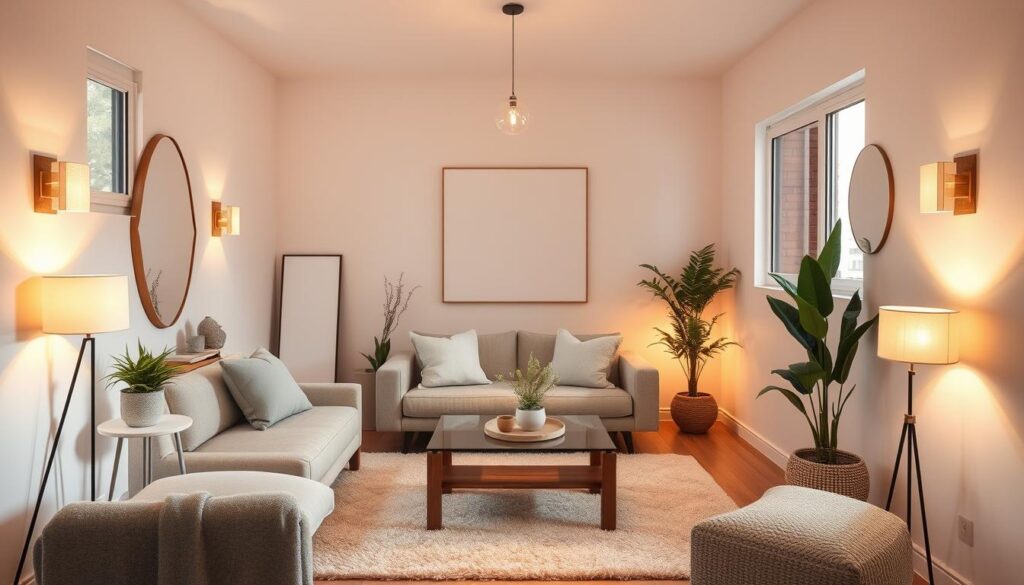
Layering Artificial Lighting
Natural light is great, but it’s not always there. That’s when layering artificial lighting helps. It means using different lights to create a balanced look.
Start with ambient lighting for overall light. Use task lighting for specific tasks, like reading. And add accent lighting to highlight certain areas. This mix of lights makes your space flexible and well-lit.
| Lighting Type | Purpose | Examples |
|---|---|---|
| Ambient Lighting | Overall Illumination | Ceiling Fixtures, LED Panels |
| Task Lighting | Specific Tasks | Desk Lamps, Reading Lights |
| Accent Lighting | Highlighting Features | Spotlights, Under-Cabinet Lighting |
By using these lighting tips, you can make your small home feel bigger and more welcoming. Whether it’s through natural light or artificial lighting, the right approach can really change your space.
Incorporating Nature into Small Interiors
Bringing the outdoors into small homes can really improve their feel. Adding natural elements creates a calm and organic vibe. This makes the space feel more inviting.
Indoor Plants that Thrive in Limited Spaces
Choosing the right indoor plants is key for small house interior design. Look for plants that are small, easy to care for, and can do well in tight spots. Here are some great picks:
- Snake plants, known for their air-purifying qualities and ability to grow in low light.
- ZZ plants, which are low-maintenance and can survive with minimal watering.
- Pothos, a versatile, trailing plant that can grow in various lighting conditions.
Benefits of Natural Elements
Adding natural elements to your tiny home decorating ideas has many perks. They not only look good but also make the air cleaner. Plants, wood, and stone can purify the air, lower stress, and connect us to nature.
Also, natural elements help make small spaces feel bigger. By carefully adding these elements, we can make our homes feel more open and welcoming.
Open Floor Plans: Pros and Cons
Open floor plans in small homes offer both benefits and challenges. Knowing the pros and cons helps homeowners make smart choices for their space.
Designing Distinct Zones
Open floor plans let you create different zones in one area. Use furniture, lighting, and design elements to set up each zone. For example, a sofa and coffee table can mark a living area, while a dining table and chairs can define the dining space.
Using different flooring or colors can also help. A hardwood floor in the living area and a rug in the dining area can make each space stand out.
Using Rugs for Definition
Rugs are great for dividing open floor plans. Choose rugs with different colors, textures, or patterns to separate zones. A bold, patterned rug can highlight a seating area, while a simple rug can define a dining space.
Here’s a look at how different rugs can shape your space:
| Rug Type | Effect on Space | Ideal Use |
|---|---|---|
| Bold, Patterned | Creates a focal point, defines a specific area | Seating areas, living rooms |
| Simple, Solid-Colored | Provides a clean, minimalist look, subtly defines a space | Dining areas, bedrooms |
| Textured | Adds depth, can help to distinguish between areas | High-traffic areas, transition zones |
By using these design tips, homeowners can make the most of their open floor plan. They can create a space that is both functional and beautiful.
Clever Use of Wall Space
In small homes, walls are more than just boundaries. They offer a chance for creative storage and decor. Using your wall space wisely can make your home both functional and beautiful.
Shelving Ideas for Small Walls
For shelving in small homes, focus on using space without clutter. Floating shelves are great because they save space and look sleek.
- Use them to display decorative items or books.
- Install them near windows to create a cozy reading nook.
- Opt for shelves with a small footprint to save space.
Ladder shelves are another smart choice. They’re functional and stylish. You can lean them against a wall, saving floor space.
| Shelving Type | Benefits | Ideal Use |
|---|---|---|
| Floating Shelves | Space-saving, versatile | Displaying decor, books |
| Ladder Shelves | Modern look, easy access | Storage in living areas, bedrooms |
| Corner Shelves | Utilizes dead space, decorative | Plants, decorative items in corners |
Art Placement Strategies
Artwork can make your small home feel bigger and more welcoming. Think about the size of the art compared to the wall and furniture.
A big piece can be a centerpiece. Smaller pieces can be grouped for a gallery wall. Gallery walls are great in small homes because they add interest without taking up much space.
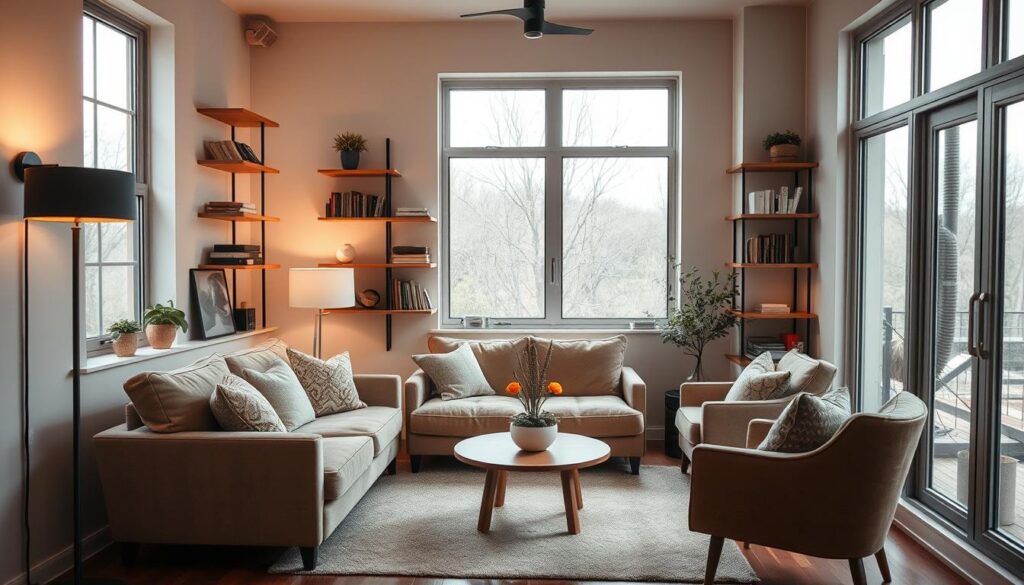
To make your small home beautiful and functional, balance form and function. This way, you’ll have a home that looks good and works well.
Personalizing Small Spaces
Making your small home your own means adding personal touches. It’s about creating a space that looks great and feels like home. Personalization turns a tiny home into a cozy retreat.
Incorporating Personal Touches
Adding personal touches is a simple way to make your space unique. This can include family photos, heirlooms, or unique decorative items that tell a story. For inspiration, check out cozy chic tiny home interior design to see how others have done it.
Displaying personal items adds character and makes your home welcoming. Use shelves or display cases to show off your favorite pieces.
DIY Decor Ideas
DIY decor projects are a great way to add a personal touch. You can make handmade wall art or customize furniture. Upcycling old items is also a fun and eco-friendly way to decorate.
Start with ideas like creating a gallery wall with your favorite photos or making your own throw pillows. You can also repurpose old furniture into something new and unique.
By adding personal touches and doing DIY decor, you can make your small space truly yours. It’s all about trying new ideas and having fun.
Balancing Style with Practicality
Designing a small home means finding a balance between style and practicality. Compact home decor ideas show us how to make a space both beautiful and useful.
In small house interior design, we face a challenge. We need to mix beauty with function. This means choosing between how a space looks and how it works.
Aesthetic vs. Functionality
The debate between beauty and function is big in interior design. For small homes, we must focus on function but keep it stylish. Using furniture that does more than one thing helps a lot.
Using light colors on walls and floors makes a space look bigger. It helps with both looks and use. Also, mirrors can make a room feel more open.
Budget-Friendly Choices
It’s possible to be stylish without spending a lot. There are many ways to decorate a small home without breaking the bank. For example, you can give old furniture a new life.
Looking for sales or making your own decor can save money. Being creative and smart can help you create a home that’s both stylish and practical.
In short, designing a small home needs careful thought and creativity. By using compact home decor ideas and small house interior design tips, you can have a home that looks great and works well.
Seasonal Updates for Small Homes
Updating your small home seasonally keeps it feeling fresh and exciting. Seasonal decor changes can breathe new life into your space. This makes your home feel new again.
Refreshing Your Space
Changing themes throughout the year is a great way to update your home. For example, using lighter colors and fabrics in spring can make your living room feel new. On the other hand, warm textiles and lighting in winter create a cozy atmosphere.
Easy Decor Swaps
Simple decor swaps can also make a big difference. Swapping throw pillows, rugs, and wall decor can give your space a fresh look. These small changes keep your home feeling current and stylish.
By making these seasonal updates, you can enjoy a home that feels revitalized. It will reflect your personal style, all while making the most of your small living space.
